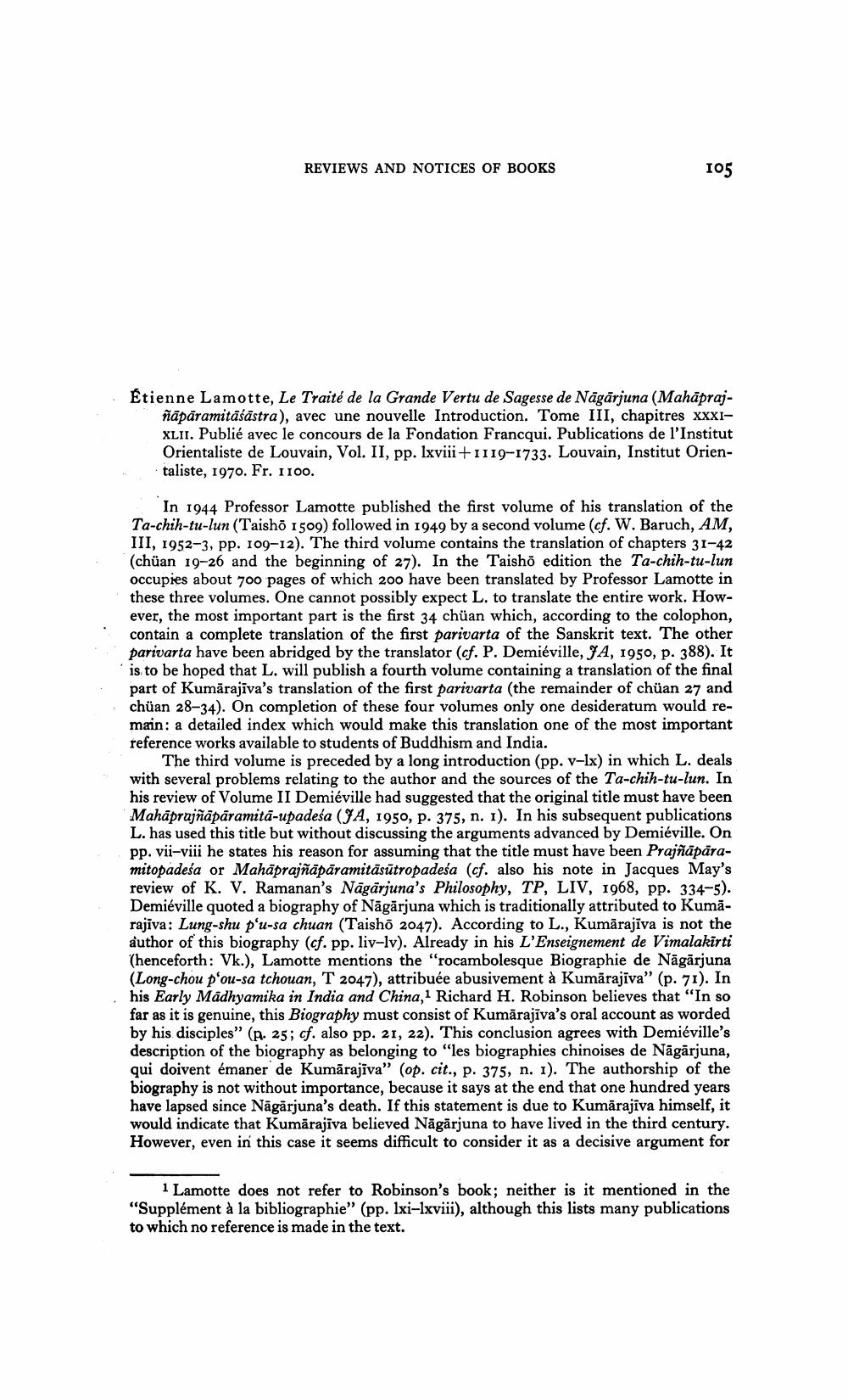Book Title: Reviews Of Etienne Lamotte Author(s): J W De Jong Publisher: J W De Jong View full book textPage 1
________________ REVIEWS AND NOTICES OF BOOKS 105 Étienne Lamotte, Le Traité de la Grande Vertu de Sagesse de Nāgārjuna (Mahāprajñāpāramitāśāstra), avec une nouvelle Introduction. Tome III, chapitres XXXIXLII. Publié avec le concours de la Fondation Francqui. Publications de l'Institut Orientaliste de Louvain, Vol. II, pp. lxviii+1119-1733. Louvain, Institut Orientaliste, 1970. Fr. 1100. In 1944 Professor Lamotte published the first volume of his translation of the Ta-chih-tu-lun (Taishō 1509) followed in 1949 by a second volume (cf. W. Baruch, AM, III, 1952-3, pp. 109-12). The third volume contains the translation of chapters 31-42 (chüan 19-26 and the beginning of 27). In the Taishō edition the Ta-chih-tu-lun occupies about 700 pages of which 200 have been translated by Professor Lamotte in these three volumes. One cannot possibly expect L. to translate the entire work. However, the most important part is the first 34 chüan which, according to the colophon, contain a complete translation of the first parivarta of the Sanskrit text. The other parivarta have been abridged by the translator (cf. P. Demiéville, JA, 1950, p. 388). It is to be hoped that L. will publish a fourth volume containing a translation of the final part of Kumārajīva's translation of the first parivarta (the remainder of chüan 27 and chüan 28-34). On completion of these four volumes only one desideratum would remain: a detailed index which would make this translation one of the most important reference works available to students of Buddhism and India. The third volume is preceded by a long introduction (pp. v-lx) in which L. deals with several problems relating to the author and the sources of the Ta-chih-tu-lun. In his review of Volume II Demiéville had suggested that the original title must have been Mahāprajñāpāramitā-upadeśa (JA, 1950, p. 375, n. 1). In his subsequent publications L. has used this title but without discussing the arguments advanced by Demiéville. On pp. vii-viii he states his reason for assuming that the title must have been Prajñāpāramitopadeśa or Mahāprajñāpāramitāsūtropadeśa (cf. also his note in Jacques May's review of K. V. Ramanan's Nagarjuna's Philosophy, TP, LIV, 1968, pp. 334-5). Demiéville quoted a biography of Nagarjuna which is traditionally attributed to Kumārajiva: Lung-shu p'u-sa chuan (Taishō 2047). According to L., Kumārajīva is not the author of this biography (cf. pp. liv-lv). Already in his L'Enseignement de Vimalakirti (henceforth: Vk.), Lamotte mentions the "rocambolesque Biographie de Nagarjuna (Long-chou pou-sa tchouan, T 2047), attribuée abusivement à Kumārajīva" (p. 71). In his Early Madhyamika in India and China,1 Richard H. Robinson believes that "In so far as it is genuine, this Biography must consist of Kumārajīva's oral account as worded by his disciples" (p. 25; cf. also pp. 21, 22). This conclusion agrees with Demiéville's description of the biography as belonging to "les biographies chinoises de Nagarjuna, qui doivent émaner de Kumārajīva" (op. cit., p. 375, n. 1). The authorship of the biography is not without importance, because it says at the end that one hundred years have lapsed since Nagarjuna's death. If this statement is due to Kumarajiva himself, it would indicate that Kumārajīva believed Nagarjuna to have lived in the third century. However, even in this case it seems difficult to consider it as a decisive argument for 1 Lamotte does not refer to Robinson's book; neither is it mentioned in the "Supplément à la bibliographie" (pp. lxi-lxviii), although this lists many publications to which no reference is made in the text.Page Navigation
1 2 3 4 5 6 7 8
